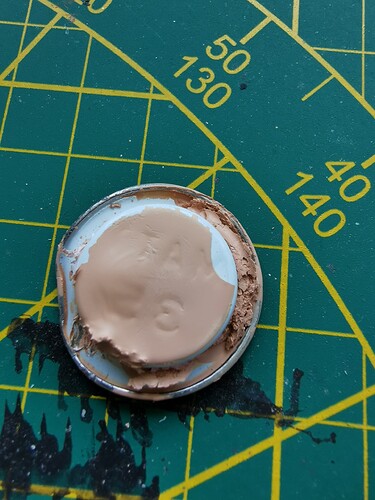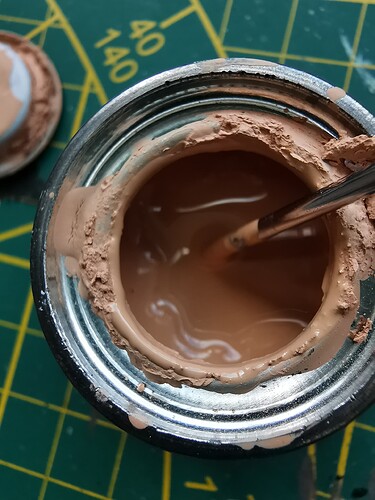I’m working on my scale model project and opened up a tin can of Revell enamel paint. And it got a crust on top. Poked through it with my Tamiya stirring bar. But I’m wondering what I can do about this. And if it is a sign that my paint is going wrong. Or could it be of the lid?
Add the correct thinner and stir it extremely well or throw it away and replace as it is cheaper than replacing the latest master piece due to paint damage.
I’m probably going for last option, since it is easier.
Please don’t take this the wrong way but it appears from your photos that perhaps you haven’t been very good about cleaning the the lids and can lips after usage. Humbrol type containers really need a little TLC before closing them or they don’t seat well and you end up with crust around the lid which prevents a good seal and allows the paint to skim over inside. I have cans of Humbrol paints that are over 40 years old that are still fresh since I wipe them down after each usage. A bit of a pain but it saves a trip to the LHS.
Well, that’s one more reason then to replace them with Tamiya acrylic paint. I really like those.
Just remember that Tamiya paint is not great for brush paining any more.
As others have said, the tins need to be properly sealed, (well even Tamiya tubs).
Clean the lid and rim, before closing up.
You ‘could’ revive the paint in the tin (not the crust) with enamel (or lacquer, tst first) thinners, but you risk adding extra lumpy bits to your airbrush or model finish.
Buy new paint
I use paints that are well over twenty years old. I’m trying to help my daughter save the planet by not tossing paint that doesn’t need to be tossed. A lot of those old paints are irreplaceable.
You can thin it and and strain it into another bottle through panty hose. I generally strain acrylic even if it is not old anyway, especially if I’m really being OCD on that particular day.
To add to @18bravo comments, you can purchase inexpensive disposable paint strainers from Amazon or any paint store. For model building, buy the smallest size you can find.
However, you can also fabricate a cheap, one-use strainer from a few square inches of women’s hose and the corner cut from a mailing envelope. Cut the envelope in an arc about 3" from the corner. Trim the corner point off to leave a hole about 1/4." Tape the piece of panty hose to the outside of this envelope corner, over the small hole and then open it up to form a small funnel or cone. Pour your paint through this strainer to remove clumps and lumps and hardened paint. Throw away when done. Only cost is a few minutes of time to make.
Yes, that is true, however, why do that if you have good paint that would remain good paint if you used a little TLC to keep it that way. Tamiya paints are great for airbrushing but as CMOT says, they’re not the best for brush painting. I have an extensive collection of various brands of paint that each have certain qualities that I find are better for different applications. I have found that very few paints are great for EVERY application. But as the old saying goes “To each his own!”
That’s what makes this hobby so much fun is experimenting with paints, glues, tools, etc. and sharing that info with fellow modelers. Just remember to always have FUN an keep an open mind.
I’m personally have no problems with brush painting Tamiya since I got the tip from a previous topic of mine to always use a pallet and never to paint straight out of the bottle. With the right amount of paint retarder of Tamiya, paint flows really nice. And it doesn’t leave brush marks. I believe it even levels out on it’s own when left alone. Anyway, I’m liking Tamiya paints. I guess that is my personal preference for paint now.
That’s awesome! Thanks for sharing.
Sort of agree with 18bravo, I have Humbrol & Tamiya paints from last Century, 30+ YEARS OLD!
Most of the ones properly sealed/unused are still good to go, but I’d toss any like modelbouwnederland’s pic, or relegate to groundwork with a hairy stick, as I wouldn’t risk the work time & effort put in a model to save a few quid/bucks/Euros
Reopened a tin of Humbrol “Panzer Gray” last used in 1988, today. Thirty-five years later just as good as new. Key as mentioned above is cleaning the lip of the tin and lid before resealing.

